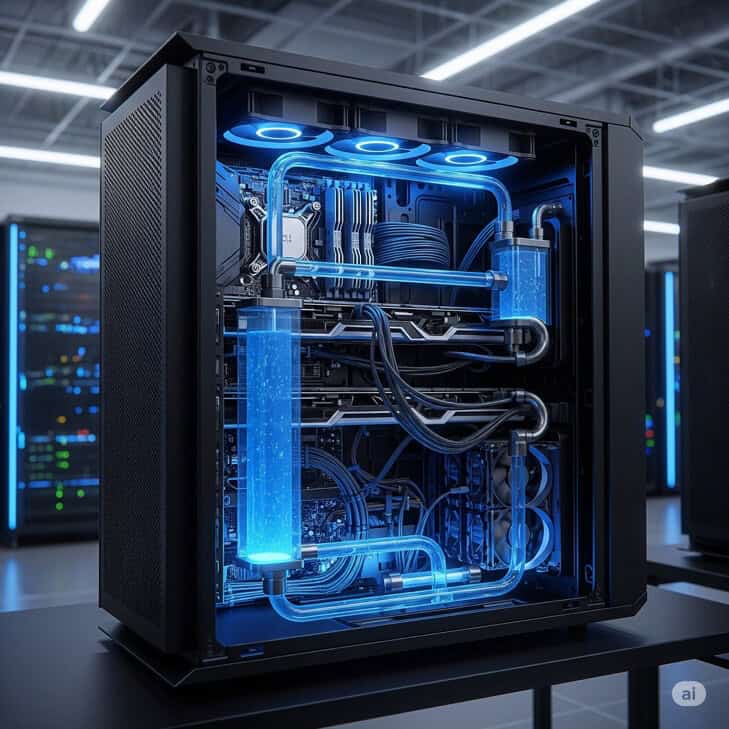With the rapid development of artificial intelligence (AI) technology, the demand for high-performance servers is increasing. Traditional air-cooled cooling methods have been unable to meet the heat dissipation needs of high-density computing environments, making liquid cooling technology a key solution for data centers and edge computing facilities. Among the many liquid cooling media, PG 25 (Propylene Glycol 25%) coolant is widely used in closed-loop cooling systems due to its excellent thermal conductivity and system compatibility.
However, despite the many advantages of PG 25 coolant, the long-term operation of closed-loop cooling systems presents several challenges. These challenges include:
- Corrosion issues: Poor coolant quality or improper system maintenance can lead to corrosion of metal components, affecting heat dissipation efficiency and even causing leaks.
- Microbial growth: Microbial contamination within the system can form biofilms, clog channels, and reduce heat exchange efficiency.
- Deposit formation: Impurities or corrosion products can form deposits that adhere to heat exchange surfaces, affecting heat dissipation and increasing the burden on the pump.
- Coolant degradation: Long-term high-temperature operation will lead to degradation of coolant components, losing the original anti-corrosion and buffering capacity.
- Leakage Risk: Any tiny leak can cause damage to delicate electronics.
In order to meet these challenges and ensure the long-term stable operation of the cooling system, regular and comprehensive coolant quality testing is essential. Through professional inspection services, potential problems can be detected early, equipment failures can be avoided, system life can be prolonged, energy efficiency can be improved, and maintenance costs can be reduced.
For the quality management of PG 25 coolant, the following key tests are particularly important:
- Viscosity: PG 25 coolant can increase its viscosity due to high temperature degradation, contaminant accumulation or microbial growth during long-term operation, which in turn will affect fluid flow and system heat dissipation efficiency. Regular monitoring of viscosity changes can help detect coolant performance anomalies early.
- Turbidity: Turbidity is a visual indicator of coolant cleanliness and reflects the amount of particulates, microorganisms or chemical deposits in it. An abnormally high turbidity usually means that the coolant has been contaminated, which can affect the heat transfer efficiency.
- Electrical conductivity: The conductivity of coolant is a key parameter to measure its ionic impurity content. A high degree of electrical conductivity may indicate that the coolant contains too many ionic contaminants, such as chloride or sulfate, which will increase the risk of corrosion.
- IC Trace Anion and Cation Analysis: Through ion chromatography (IC) technology, trace anions (such as chloride ions, sulfate ions) and cations (such as sodium ions, potassium ions) can be accurately analyzed in coolants. The concentration of these trace ions is critical for assessing the purity of the coolant and the potential risk of corrosion.
- Particle cleanliness: Tiny particles in the cooling system, such as metal shavings, dust, or degradation products, can clog pipes and affect cooling performance. Particle cleanliness analysis of coolant can effectively assess the cleanliness of the system and suggest necessary liquid filtration or cleaning maintenance of related parts.
- pH : Coolant is usually designed in a weakly alkaline range (e.g. pH 8.0~9.5) to inhibit metal corrosion and microbial growth. When the pH level drops due to degradation or contaminant accumulation, it accelerates corrosion of metal components and reduces the system’s ability to buffer and prevent rust. pH is a key indicator of the acidity, alkalinity and chemical stability of a coolant, and regular monitoring can help detect anomalies early and maintain the reliability of system operation.
Eco-lander Precision Tech can provide the above six important tests for AI server cooling manufacturers, so that enterprises can regularly grasp the health status of PG 25 coolant, identify and solve potential problems early, ensure the long-term stable and reliable operation of high-performance server cooling systems, and provide solid heat dissipation guarantee for data centers in the AI era.


